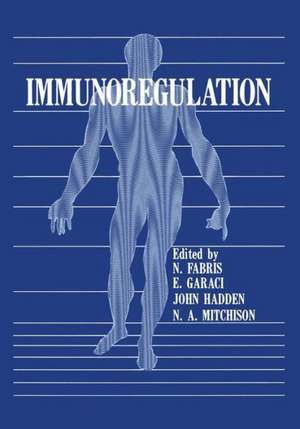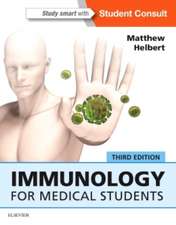Immunoregulation
Editat de Nicola Fabrisen Limba Engleză Paperback – 14 mar 2012
Preț: 385.94 lei
Preț vechi: 406.25 lei
-5% Nou
Puncte Express: 579
Preț estimativ în valută:
73.85€ • 77.10$ • 61.12£
73.85€ • 77.10$ • 61.12£
Carte tipărită la comandă
Livrare economică 04-18 aprilie
Preluare comenzi: 021 569.72.76
Specificații
ISBN-13: 9781468445497
ISBN-10: 1468445499
Pagini: 492
Ilustrații: X, 478 p.
Dimensiuni: 178 x 254 x 26 mm
Greutate: 0.84 kg
Ediția:Softcover reprint of the original 1st ed. 1983
Editura: Springer Us
Colecția Springer
Locul publicării:New York, NY, United States
ISBN-10: 1468445499
Pagini: 492
Ilustrații: X, 478 p.
Dimensiuni: 178 x 254 x 26 mm
Greutate: 0.84 kg
Ediția:Softcover reprint of the original 1st ed. 1983
Editura: Springer Us
Colecția Springer
Locul publicării:New York, NY, United States
Public țintă
ResearchCuprins
IgVH and MHC-Restricted Regulatory Circuit in the Immune Response.- Subpopulations of Human Lymphocytes and their Alterations in Immunodeficiency Diseases.- T-Cell Independent Activation of Human B Cells by Anti-Ig Antibodies and Protein A-Containing Staphylococci.- The Rise and Fall of the Antigen Bridge.- Primate Helper Factors: Comment on the ‘Antigen Bridge’.- Immunoregulation of “In Vitro” Antibody Response to Azobenzenearsonate (Aba)-Proteins.- Is the Immune System a Functional Idiotypic Network?.- Systemic Network Regulation Hypothesis: Some Experimental Evidence.- Antigen Specific Helper Factors: an Overview After Ten Years.- Fine Specificity of H-2-Restricted, Lysozyme Specific Suppressor T Cell Factor.- Marrow Regulating Factors (MRF) and Radiation Chimeras: a Model for Bone Marrow-Directed Immunity.- Role of Thymosin and the Neuroendocrine System in the Regulation of Immunity.- Thymic Factors in Experimental Diseases.- Lymphokines and the Lymphoendothelial System: an Illustration of Immunoregulatory Integration.- Cyclic Nucleotides and Related Mechanism in Immune Regulation: a Mini Review.- Anatomical and Physiological Connections Between the Central Nervous and the Immune Systems (Neuroimmunomodulation).- Immunoendocrinology: Endocrine Aspects of Autoimmune Disease.- Prostaglandins and Immunoregulation.- Behavioral Conditioning and Immunity.- Neuroendocrine Immunoregulation.- Thymus-Neuroendocrine Network.- Myasthenia Gravis: Thymic and Peripheral Blood Cell Interactions in Specific Antibody Production.- Muscular Dystrophies and Thymic Deficiency.- Ataxia-Telangiectasia: a Neuro-Endocrine-Immune Disease? Alternative Models of Pathogenesis.- Accelerated Aging in Down’s Syndrome: the Concept of Hierarchical Homeostasis in Relation to Local and GlobalFailure.- Natural Resistance Against Tumors In Vivo.- Immunogenetic Determinants Controlling the Metastatic Properties of Tumor Cells.- Contributors.











